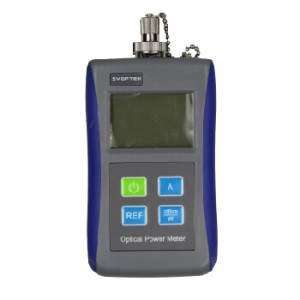 Fiber optic power meter measures how much light is coming out of a fiber optic cable; it can be used to determine the amount of light being generated by an optical source, or the amount of light being coupled into an optical receiver.
Fiber optic power meter measures how much light is coming out of a fiber optic cable; it can be used to determine the amount of light being generated by an optical source, or the amount of light being coupled into an optical receiver.
Optical power is usually measured in dBm, or decibels referenced to 1mW. These devices measure the average optical power, no the peak power, so they are sensitive to the duty cycle of the data transmitted. Their wavelength and power range have to be appropriately matched to the system being measured.
Most power meters used to best communication networks are designed to work at 850nm, 1300nm, and 1550nm wavelength ranges and in the power range of –15dBm to –35dBm for multimode links, or 0-40 dBm for single mode links.
Our hand held type fiber optic test equipment features ergonomically design, wide optical power measurement range, high test precision and automatic self calibration function. Fiber optic power meter is a must have tool for telecom and CATV network installation and maintenance.
Hand held fiber optic power meter features automatic self calibration function, backlight on-off optional function, large LCD display window which can display optical power in mW, dB and dBm.
The hand held fiber power meter can work in absolute and relative power measurement. It features quick response, no warm-up damp, dust and water proof design, low battery consumption (more than 240 hours continual operation with three 1.5V batteries), lightweight and small footprint.
There is also a type of test kit on the market called optical loss test kit. An optical loss test kit includes a fiber optic power meter and a test light source. An optical loss test set (OLTS) includes a meter and source in one package, but since the source must be on one end of the cable, the meter on the other, you need two of the these in order to make a measurement.
A test source is a portable version of the transmitter attached to the fiber, and should match the wavelength and source type in the system. Generally, multimode fiber is tested with LEDs at 850nm and 1300nm, and single mode fiber is tested with lasers at 1310nm and 1550nm.
Some cable measurements require a reference cable, also known as a test jumper. This is used to calibrate measurements to be made with an optical power meter, for comparison purposes with a fiber or component that may not be working properly. It is important to test these cables frequently, because their failure can invalidate an entire measurement procedure; it is also important to verify that the reference cable is matched properly to the size cable that is being tested, such as 62.5um or 50um multimode cable or 8.3um and 9um single mode cable.